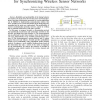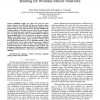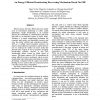120 search results - page 8 / 24 » Understanding the Flooding in Low-Duty-Cycle Wireless Sensor... |
SECON
2010
IEEE
13 years 5 months ago
2010
IEEE
Reliability and predictability of the timing behavior have shown to be major issues for wireless sensor network deployments. Real-time requirements presented by several application...
ICC
2009
IEEE
14 years 2 months ago
2009
IEEE
—Multipath routing can reduce the need for route updates, balance the traffic load and increase the data transfer rate in a wireless sensor network, improving the utilization of ...
GLOBECOM
2007
IEEE
14 years 1 months ago
2007
IEEE
— An opportunistic large array (OLA) is a form of cooperative diversity in which a large group of simple, inexpensive relays or forwarding nodes operate without any mutual coordi...
SENSYS
2003
ACM
14 years 21 days ago
2003
ACM
Wireless sensor networks promise fine-grain monitoring in a wide variety of environments. Many of these environments (e.g., indoor environments or habitats) can be harsh for wire...
MUE
2007
IEEE
14 years 1 months ago
2007
IEEE
Wireless Sensor Networks (WSNs) have been widely used in environment monitoring to collect useful information. Packet broadcasting is an essential function for establishing a comm...



